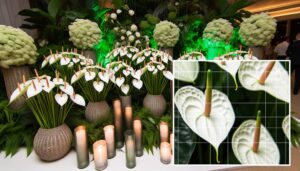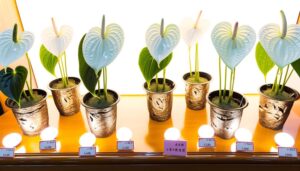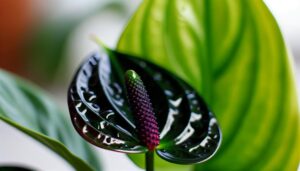How to Care for Anthurium Sierra White
Caring for Anthurium Sierra White involves precise environmental and physiological conditions. Position the plant in bright, indirect light, avoiding photodamage from direct sunlight.
Maintain soil moisture with weekly watering using lukewarm, dechlorinated water without waterlogging. Utilize a well-ventilated, nutrient-rich mix comprising peat, pine bark, and perlite.
Guarantee the environment has 70-80% relative humidity and is within a temperature range of 65-80°F. Prune using sanitized tools and manage pests with neem oil or insecticidal soap.
Repot biennially with proper drainage to prevent root rot. For successful growth and more intricate care techniques, further insights are beneficial.

Key Takeaways
- Place Anthurium Sierra White in bright, indirect light, avoiding direct sunlight.
- Water every 1-2 weeks with lukewarm, dechlorinated water, ensuring soil is consistently moist but not waterlogged.
- Use a well-ventilated soil mix of peat, pine bark, and perlite for optimal drainage and aeration.
- Maintain high humidity levels (70-80%) and keep the temperature between 65°F and 80°F.
- Repot every 2-3 years using a slightly larger pot and a well-draining, organic-rich soil mix.
Ideal Lighting Conditions
Anthurium Sierra White flourishes best in bright, indirect light, which mimics the dappled sunlight of its native tropical understory habitats. Optimum light conditions are vital for photosynthesis and overall plant health. Direct sunlight can cause photodamage, leading to chlorosis or necrosis on the foliage.
Conversely, inadequate light may result in etiolation, where the plant exhibits elongated, weak growth and reduced flowering. The perfect setting involves placing the plant near east or north-facing windows, offering filtered light without direct exposure. Artificial grow lights with a color temperature of 6500K can supplement natural light, ensuring consistent luminosity.
Monitoring light intensity using a photometer can help maintain levels between 10,000 to 20,000 lux, approximating its natural environment.
Watering Guidelines
Maintaining ideal hydration is essential to the health of Anthurium Sierra White, as improper watering can lead to root rot or desiccation, impacting plant vitality. Best watering involves guaranteeing the substrate is consistently moist but not waterlogged. Employing a moisture meter can help determine appropriate hydration levels.
Watering should be thorough, allowing excess to drain, preventing stagnation that fosters pathogenic fungi. Frequency is contingent upon environmental conditions; typically, watering every 1-2 weeks suffices, with increased frequency during warmer periods. Utilize lukewarm, dechlorinated water to prevent shock and mineral buildup.
Observing foliage can provide cues; drooping or yellowing leaves may indicate improper watering. Consistent monitoring and adjustment of watering practices ensure robust growth and prolonged plant health.
Soil Requirements
Anthurium Sierra White flourishes in a well-ventilated, nutrient-rich soil medium that mimics its native tropical habitat. Peak soil composition should include a mix of peat, pine bark, and perlite to guarantee sufficient drainage and prevent waterlogging.
Introducing organic amendments such as compost or worm castings can further enrich soil fertility and provide crucial micronutrients.
Ideal Soil Composition
Perfect soil composition for Anthurium Sierra White requires a well-draining, nutrient-rich medium with a slightly acidic to neutral pH range of 5.5 to 6.5.
A suitable substrate typically includes a blend of peat moss, pine bark, and perlite to guarantee optimal moisture retention and aeration. The peat moss component provides necessary organic matter and aids in maintaining the slightly acidic pH, while pine bark enhances drainage and aeration. Perlite, an inert volcanic glass, contributes to soil aeration and prevents compaction, promoting robust root development.
Additionally, incorporating a slow-release balanced fertilizer can support sustained nutrient availability. Ensuring these elements are in balance is crucial for the Anthurium Sierra White's growth and overall essentiality, preventing root rot and other soil-borne issues.
Drainage and Aeration
Proper drainage and aeration are critical soil requirements for Anthurium Sierra White, ensuring that excess water is efficiently removed and sufficient oxygen reaches the root zone to prevent anaerobic conditions.
A well-draining substrate, such as a mix of pine bark, perlite, and peat moss, facilitates rapid water evacuation while maintaining proper air pockets within the soil structure. This combination helps avert root rot, a common issue in overly saturated soils.
Additionally, container choice is paramount; pots with multiple drainage holes are recommended to further aid water expulsion. Regular monitoring of soil moisture levels, using a moisture meter, can prevent waterlogging.
The incorporation of coarse materials like orchid bark can greatly enhance soil aeration, promoting robust root health and best plant growth.
Nutrient-Rich Amendments
In addition to ensuring adequate drainage and aeration, incorporating nutrient-rich amendments such as compost, worm castings, and slow-release fertilizers into the soil mix is essential for fostering ideal growth and vibrant foliage in Anthurium Sierra White.
Compost provides a balanced spectrum of macronutrients and micronutrients, enhancing soil structure and microbial activity.
Worm castings, rich in nitrogen, phosphorus, and potassium, promote robust root development and disease resistance.
Slow-release fertilizers deliver a steady supply of essential nutrients over time, ensuring consistent uptake by the plant.
These amendments not only improve nutrient availability but also enhance water retention and soil pH balance, creating an excellent growing environment.
Regularly replenishing these components will sustain the plant's health and aesthetic appeal.
Humidity Needs
Anthurium Sierra White thrives in environments where relative moisture levels are consistently maintained between 70% and 80%. Elevated moisture is essential for best physiological processes, including transpiration and nutrient uptake.
Low moisture conditions can lead to desiccation of foliar tissues, appearing as brown leaf margins and reduced overall vigor. Conversely, maintaining high moisture levels can be achieved through the use of humidifiers, pebble trays, or periodic misting.
This species benefits from microenvironments that simulate its native tropical habitat, ensuring sustained moisture availability. It is crucial to avoid excess water on foliage, which can lead to fungal infections.
Implementing these moisture management strategies will greatly enhance the Anthurium Sierra White's growth and aesthetic appeal.
Temperature Tolerance
Maintaining ideal temperature conditions, ranging between 65°F to 80°F, is equally crucial for the Anthurium Sierra White to thrive, as these parameters closely resemble its native tropical environment.
Deviations outside this range can induce thermal stress, potentially leading to stunted growth and increased vulnerability to diseases. Prolonged exposure to temperatures below 60°F can cause cellular damage, appearing as foliar discoloration and necrosis.
Conversely, temperatures exceeding 85°F may accelerate transpiration rates, leading to dehydration and foliar wilting. It is essential to provide a stable microclimate, avoiding sudden temperature fluctuations.
Utilizing horticultural temperature control devices, such as thermostats and humidistats, can guarantee ideal thermal conditions, thereby promoting strong physiological functions and overall plant health.
Fertilizing Tips
Proper fertilization is essential for the robust growth and vibrant foliage of the Anthurium Sierra White, necessitating a balanced nutrient regimen tailored to its specific developmental needs. Employing a high-phosphorus fertilizer, such as a 10-30-20 N-P-K formulation, can greatly enhance flowering and root development.
Application should be bi-monthly during the growing season, ensuring the soil is consistently moist to facilitate nutrient uptake. Dilute the fertilizer to half its recommended strength to prevent root burn and nutrient overload.
Monitoring for signs of nutrient deficiencies, such as chlorosis or stunted growth, is critical for timely intervention. Additionally, incorporating organic matter, like compost or well-rotted manure, can improve soil structure and provide a slow-release source of essential micronutrients.
Pruning Techniques
Equally important to the plant's health as fertilization, precise pruning techniques are crucial for maintaining the Anthurium Sierra White's aesthetic appeal and best growth. Pruning should be conducted with sanitized tools to prevent pathogen transmission.
Remove spent flowers and yellowing leaves to redirect the plant's energy towards new growth. Additionally, thinning out crowded areas improves air circulation, reducing the risk of fungal infections.
- Sanitize tools: Use isopropyl alcohol to clean shears before pruning.
- Eliminate dead foliage: Cut back any yellow or brown leaves at their base.
- Trim spent flowers: Remove wilted blooms to promote further flowering.
- Thin dense growth: Prune crowded areas to enhance air circulation and light penetration.
These steps guarantee the Anthurium Sierra White remains vibrant and healthy.
Pest Control
Effective pest control is essential for maintaining the health of Anthurium Sierra White. Common insect pests include aphids, spider mites, and mealybugs, which can cause significant damage to the plant's foliage.
Utilizing natural pest remedies, such as neem oil and insecticidal soap, can mitigate infestations without harming the plant.
Common Insect Pests
Anthurium Sierra White is susceptible to several common insect pests, including aphids, spider mites, and mealybugs, which can cause significant damage if not promptly managed. These pests are notorious for their ability to rapidly colonize and compromise plant health through sap extraction, leading to stunted growth and deformities.
Key pest indicators and their effects include:
- Aphids: Small, soft-bodied insects that cluster on new growth, excreting honeydew which attracts sooty mold.
- Spider Mites: Tiny arachnids causing stippling and yellowing of leaves; webs may be visible in severe infestations.
- Mealybugs: Cotton-like masses on stems and leaves, leading to chlorosis and wilting.
- Thrips: Slender insects causing silvering of leaf surfaces, and potential vectoring of viral pathogens.
Effective management requires vigilant monitoring and timely intervention.
Natural Pest Remedies
Frequently, natural pest control remedies can provide an effective and environmentally friendly solution for managing insect infestations in Anthurium Sierra White.
Neem oil, an organic insecticide, disrupts insect growth and prevents feeding. Dilute with water at a 2% concentration and apply bi-weekly to the foliage.
In addition, insecticidal soap, composed of potassium salts of fatty acids, effectively eradicates soft-bodied pests. Ensure thorough coverage, especially on the undersides of leaves.
Introducing beneficial insects such as ladybugs or predatory mites can serve as a biological control, preying on harmful pests.
Repotting Instructions
To maximize growth and health, repotting Anthurium Sierra White should be conducted every two to three years, preferably during the spring when the plant is most actively growing. This timing ensures best root development and nutrient uptake.
When selecting a new pot, make sure it is only slightly larger than the current one to prevent waterlogging. Utilize a well-draining mix, rich in organic matter, to replicate the plant's native epiphytic conditions.
Preparation: Thoroughly water the plant a day before repotting to minimize stress.
Root Inspection: Carefully remove the plant, inspecting for rot or damage, and trim as necessary.
Planting: Position the plant at the same depth as before, gently filling around with new substrate.
Post-repotting Care: Water lightly and place in indirect light to acclimate.
Common Issues
Encountering common issues with Anthurium Sierra White often involves addressing root rot, pest infestations, and physiological disorders related to improper watering, light exposure, and nutrient deficiencies.
Root rot, primarily caused by overwatering and poor drainage, manifests as brown, mushy roots and yellowing foliage.
Pest infestations, including aphids, spider mites, and mealybugs, can lead to distorted growth and reduced vigor, requiring prompt intervention with insecticidal soap or neem oil.
Light-related disorders encompass chlorosis and etiolation, often resulting from insufficient light.
Nutrient deficiencies, especially nitrogen, phosphorus, and potassium, are evidenced by stunted growth and discolored leaves.
Regularly monitoring and adjusting care practices can mitigate these issues, ensuring the Anthurium Sierra White remains healthy and vibrant.
Propagation Methods
Propagation of Anthurium Sierra White can be effectively achieved through two primary methods: stem cutting and seed germination.
The stem cutting technique involves selecting a healthy, mature stem and providing ideal conditions for root development.
Seed germination, on the other hand, requires specific stratification steps and controlled environmental parameters to promote successful sprouting and growth.
Stem Cutting Technique
Initiating the stem cutting technique for Anthurium Sierra White necessitates precise excision of a healthy segment containing at least one node and several aerial roots. This method, known for its efficacy, involves the following steps:
- Selection of Cutting: Choose a robust stem segment with a minimum of one node and aerial roots.
- Sterilization: Utilize sanitized cutting tools to prevent pathogenic contamination.
- Substrate Preparation: Use a well-draining medium like a mix of perlite and peat moss.
- Environment: Maintain high humidity and moderate indirect light to promote root development.
The excised stem should be planted in a moist substrate, guaranteeing the node is beneath the surface. Covering with a plastic bag can improve humidity, hastening root emergence. This propagation method guarantees genetic consistency and robust growth.
Seed Germination Steps
Seed germination for Anthurium Sierra White requires careful attention to environmental conditions, including temperature, humidity, and light exposure, to guarantee successful propagation. Best germination occurs at temperatures between 25-30°C, with humidity levels maintained at 80-90%. Seeds need to be sown in a sterile, well-draining medium and kept under indirect light to prevent scorching.
| Step | Action | Details |
|---|---|---|
| 1. Seed Selection | Choose healthy, mature seeds | Inspect for discoloration or damage |
| 2. Sterilization | Sterilize seeds in a mild bleach solution | Soak for 10 minutes, rinse thoroughly |
| 3. Sowing | Plant seeds in sterile medium | Use sphagnum moss or seed-starting mix |
| 4. Environment | Maintain best conditions | Temperature: 25-30°C, Humidity: 80-90% |
Ensuring these parameters will facilitate a high germination rate and healthy seedling development.
Conclusion
To sum up, the Anthurium Sierra White, when cared for with the attention suited to a royal heir, will flourish in conditions of ideal lighting, accurate watering, well-draining soil, sufficient humidity, and regulated temperature.
However, negligent guardianship, marked by improper pest management, careless repotting, and lack of awareness regarding common problems, will result in its premature death.
Propagation, while possible, is a task for those with a green thumb. Therefore, the Anthurium Sierra White requires not only care but a thorough, almost majestic, dedication.






